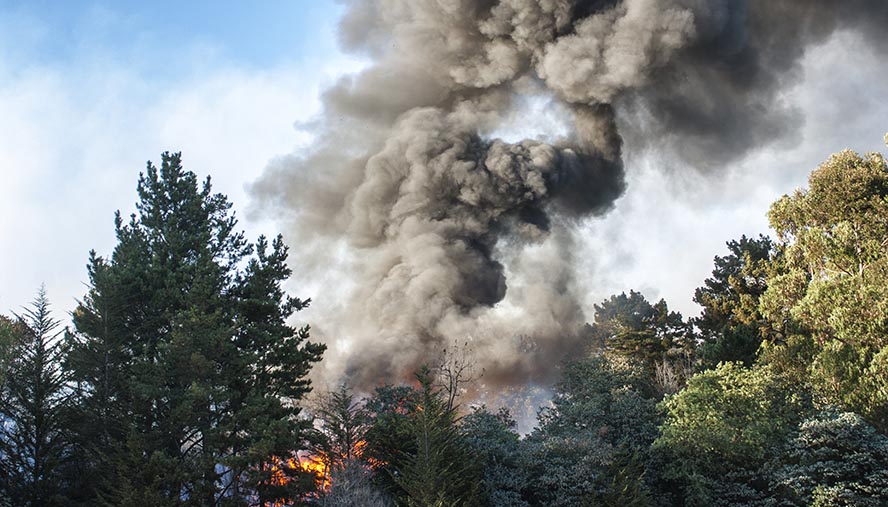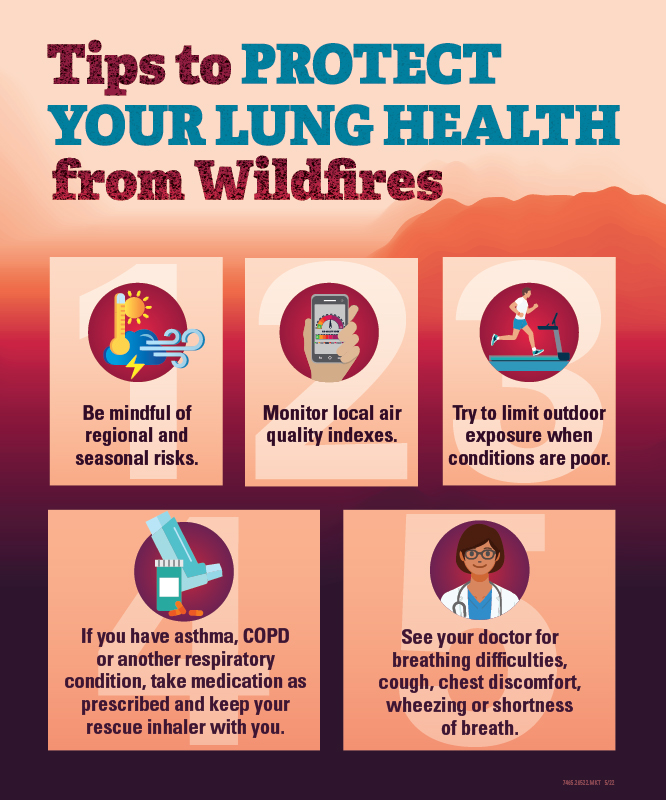How Wildfire Toxins Affect Your Lungs
This information was reviewed and approved by Anthony Gerber, MD, PhD (June 2022).
When you think of wildfire damage, you might picture forests — and increasingly homes — caught in a fast-moving blaze. However, there’s another element at stake, one that’s less obvious and perhaps even more important.
“You can rebuild a house. You can’t necessarily rebuild your lungs,” according to Pulmonologist Anthony Gerber, MD.

As wildfires become more severe and widespread, we need to increase awareness of health effects. It’s especially important to know how airborne pollution from these fires can affect your health. This knowledge is crucial even when it seems like you’re out of harm’s way.
Why Are Wildfires Getting Worse?
Since 1983, the wildfire problem in the western U.S. has been growing. Colorado, California and New Mexico have become summertime tinderboxes. The largest wildfires on record for all three states have occurred within the last two years. Climate change, drought and previous forest management practices have contributed to the problem.
It’s a problem Dr. Gerber doesn’t see going away anytime soon. “There is model after model that predicts hotter summers and more sporadic rainfall,” he noted. New home construction is piling even more fuel on the fire. “We now have this increasing tendency to build up into the wildlands,” Dr. Gerber explained. And so we’re seeing urban encroachment in areas that are simply more at risk for wildfires.”
This means that the devastation from wildfires includes more homes and personal property. And when synthetic materials burn, the health effects of wildfire smoke can be more severe.
The Particulate Problem
When something burns, it’s broken down, and its elements are released into the air, often combining with oxygen. The carbon from burnt matter can take the form of carbon dioxide (as carbon atoms bond with the oxygen).
Heavy, prolonged exposure to the carbon dioxide/monoxide in smoke can have a smothering effect. However, with a wildfire, especially one that burns homes and other structures, there are a lot more unknowns.
“You wouldn’t throw a battery onto a campfire,” explained Dr. Gerber, “but that’s what’s happening. When homes burn, along with cars and other things, you incinerate all of this material. It’s hard to quantify, but that stuff is almost certainly more toxic.” It is particularly distressing when you think of your computer, television and even refrigerator going up in smoke.
Dr. Gerber emphasized that the plume we see from a nearby wildfire is actually a particulate soup. It is peppered with toxins released from industrial materials. Plastic, for instance, produces sulfur dioxide and hydrochloric acid when burned, along with heavy metals.
A recent EPA-led study on toxic particulates showed that plastics produced the most harmful emissions. Burning plastic is more toxic than plywood, cardboard and even diesel fuel. When inhaled, these particulates can cause a range of breathing problems, especially if you have a preexisting condition.
The Western U.S is the most affected by wildfire smoke. The West tends to have drier summers. It has more forests, and it just tends to have longer and more intense wildfires. The heart of the season is really the summer and early fall. Wildfire smoke generates what we call particulate pollution, and particulate matter pollution is dangerous. It's small. It gets inhaled deep into your lungs. There's a local reaction to it, and sometimes that local reaction can cause body-wide inflammation. Not all wildfires are actually just burning trees. That smoke can contain burnt plastics, burnt metals. If batteries are burning, it can be a really toxic mix of chemicals, and then when you breathe it in all those different things can make it very inflammatory.
The most important conditions that are impacted by wildfires in terms of pulmonary disease would be asthma, chronic obstructive pulmonary disease, which is what people think about as smoking-related lung disease. Then also interstitial lung disease or pulmonary fibrosis. If you look at wildfire pollution and risk of heart attack or stroke, we will see that in response to particulate matter pollution, there's an increased risk of having those events. We ask people to look at the air quality warnings, and on the very worst days where it says it's unhealthy for everyone if you could modify your activity, maybe not exercise outside particularly in the late afternoon when the air quality is worse. That's definitely something we recommend.
The other advice that we give people is related to indoor air quality. So for some people, in their house if they keep their windows open, the air quality inside can wind up being very similar to the air quality that is outside. If people have a HEPA filter which will help keep that air quality inside cleaner. If they can afford to run their air conditioning, those strategies can at least keep the indoor air safer to breathe.
Climate change is making wildfires bigger and worse. What we can do individually is to try and reduce our footprint of greenhouse gas emissions, but we can also be mindful that other pollutants (so just normal gas-fired cars, trucks, a lot of these things which also generate particulates). If we can limit the use of those kinds of equipment and machines, that'll put us in a better position to deal with the inevitable increase in pollution from wildfire smoke that we're going to see now and over the next 10 to 20 years.
How Wildfires Affect Lung Disease
If you have a respiratory illness like asthma or COPD, even campfire smoke can be an irritant. It causes the airways to narrow and triggers breathing difficulties or asthma attacks. Wildfire smoke and its toxic particulates can make these problems even worse. The longer you are exposed to toxic smoke, the worse the health effects.
“Pretty much any preexisting lung condition can be aggravated by breathing in these particles,” according to Dr. Gerber. “You’re living with your normal asthma symptoms, and then suddenly you may have a decline. That decline might be manageable with inhalers, but sometimes it requires medical attention.”
If you have a lung condition, it’s important to monitor local air quality. Be aware of any wildfires in the region.
Do Wildfires Increase the Risk of Heart Attacks and Strokes?
Scientific evidence published by the Environmental Protection Agency (EPA) shows that exposure to these toxic particles increases everyone’s risks for heart attack and stroke. This risk for heart attack and stroke increases even if you don’t have a preexisting lung disease. The EPA says that even if you’re only exposed for a few hours, it can affect your health.
People without lung diseases aren’t as used to tracking air quality. They are perhaps less likely to avoid exposure to wildfire smoke and to notice its effects on their systems. “You may never realize that, ‘Hey, I might be more at risk for a heart attack two days from now because I was out in the pollution,’” said Dr. Gerber. “So it’s another major problem that tends to really get lost in the shuffle. We don’t pay attention to it.”
What Can We Do?
According to Dr. Gerber, individuals should work to reduce their carbon footprint. They also need to limit their contribution to climate change. But there’s nothing we can do to reverse the wildfire problem in the next five to 10 years.
Proper awareness and treatment options can help us prevent and manage the effects of wildfire pollution on our health.
Manage your condition by watching for worsening symptoms, including:
- Difficulty breathing normally
- Cough with or without mucus
- Chest discomfort
- Wheezing and shortness of breath
It’s also important to note that this area of research is still developing, and doctors are learning more every year about specific risk factors. So, keeping up to date with medical knowledge that affects you is crucial.
Final Thoughts
Particulates and air pollution have always been a concern. The spectacle of a wildfire shines a larger spotlight on the problem. “It’s so profound that I think it offers an opportunity for people to recognize the dire threats of climate change and the specific threat of increased particulate matter pollution,” said Dr. Gerber. Our knowledge in both areas is still evolving. It is his hope that the current wildfire crisis could eventually spark more public health education.

